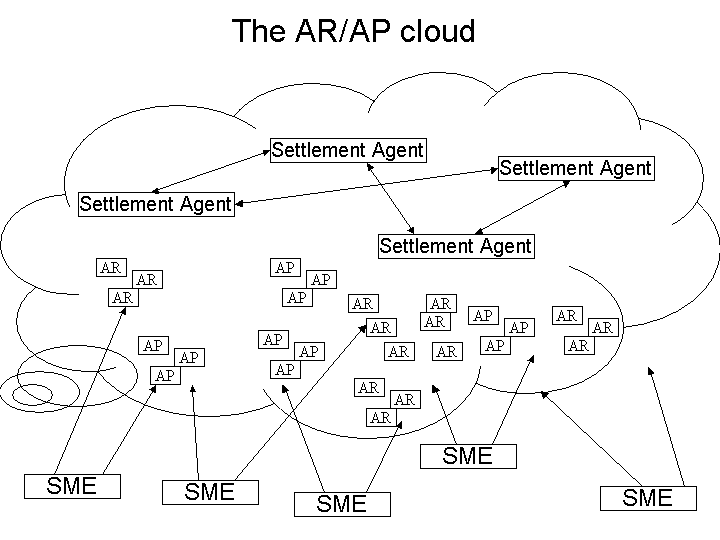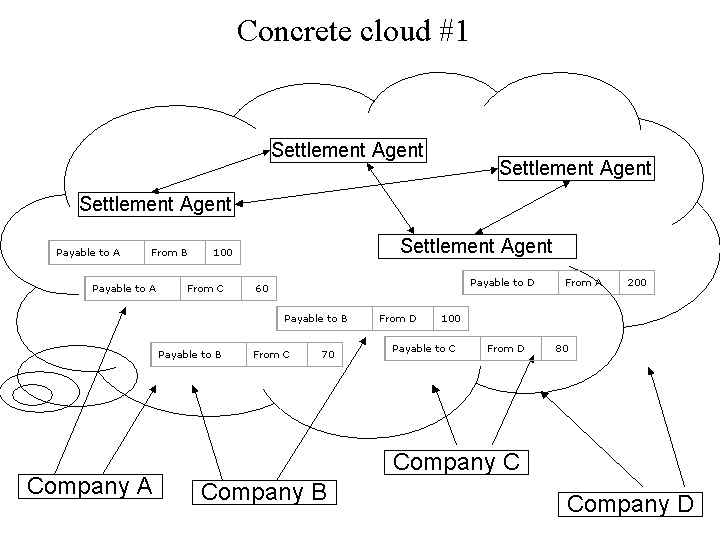Most businesses begin the year with about $1000
in their cash accounts, execute lots of transactions in
the year, and end the year with about $1000. If they are profitable
the excess goes into interest bearing accounts.
It is logically unnecessary, and very
inefficient, to send all of our transactions through banks.
Individuals and small businesses could easily bill each other by creating receivables and payables, and
allow a competitive market of settlement providers to net and offset our mutual
balances on the internet. This can be purely an information process:
- not requiring anybody to trust any customer
or supplier more than they already trust today by
extending credit,
- not requiring anybody to maintain or
exchange *any* actual money, become a "deposit-taking institution"
or fiduciary, etc. and
- not requiring that you trust any settlement
agent with anything other than to maintain confidentiality.
This can be accomplished purely as a matter of contractual netting, i.e. you agree
to give up your receivables in exchange for having a bunch of your bills paid in the
same total amount, and to maintain the difference that's leftover in either direction,
when it's over. Anytime you like, you could pay (or receive) this residual
net amount from guess who! One of the same people who owed it to you, or
who you owed, to begin with.

Now for a more concrete example:
BALANCE SHEETS, BEFORE NETTING:
| Company A |
|
| Receivables |
|
| From B |
100 |
| From C |
60 |
| Total |
160 |
|
|
| Company B |
|
| Receivables |
|
| From C |
70 |
| From D |
100 |
| Total |
170 |
|
|
| Company C |
|
| Receivables |
|
| From D |
80 |
| |
|
| Total |
80 |
|
|
| Company D |
|
| Receivables |
|
| From A |
200 |
| |
|
| Total |
200 |
|
|
|
|
|
|
| Payables |
|
| To A |
-60 |
| To B |
-70 |
|
|
| Payables |
|
| To B |
-100 |
| To C |
-80 |
|
|
|
|
|
|
|
|
|

Let us suppose the ARAP cloud in this case is eBAY,
and the four companies are in the habit of posting their bills on EBAY with
aliases. (I'm skipping a lot but each of their B2B commerce messages such
as POs and invoices, lists one of their aliases instead of their bank/ACH
number.)
Let's suppose the settlement agents are clever fellows and
can maintain a 3-column table and match debtors with creditors. Let's say
they are even clever enough to aggregate and swap payables and receivables among
themselves. They might maintain mutual balances between each other or
offload particular balances directly to the Companies in the market. In
this case let's assume there are four different SAs who happen to know these
particular companies and advertise on their website or eBAY as clearing agents
or market makers for paper issued by/against lists of aliases which they
(secretly) know are Company A,B,C
and D.
BALANCE SHEETS, AFTER NETTING:
| Company A |
|
| Receivables |
|
| |
|
| |
|
| Total |
0 |
|
|
| Company B |
|
| Receivables |
|
| From SA-32 |
70 |
| |
|
| Total |
70 |
|
|
| Company C |
|
| Receivables |
|
| |
|
| |
|
| Total |
0 |
|
|
| Company D |
|
| Receivables |
|
| From SA-9 |
20 |
| |
|
| Total |
20 |
|
|
|
|
|
|
|
|
|
|
|
|
|
|
|
|
|
The settlement agents might be banks, finance
companies, merchant account providers, etc. or may be the companies themselves,
with respect to one or another of their own customers and suppliers in some
cases. Liquidity may be initially provided within this system by prepaying of
suppliers for goods or services, for example. ) Bottom line, this
market will be very competitive indeed, and fees will be extremely low since all
these Companies already knew each other in the first place and the act of
netting will dispose of their payable and receivables in equal amounts, with
finality. There is no likelihood any company will agree to pay any
liability that isn't already on their books as an account payable, any more than
they pay fake bills from the postal mailbox. This is why it's
fundamentally different from today's "bank" economy. The
settlement agents don't assume risk. Nobody assumes anything. The
Companies either accept the netting proposal from the settlement agent or they
decline it.


